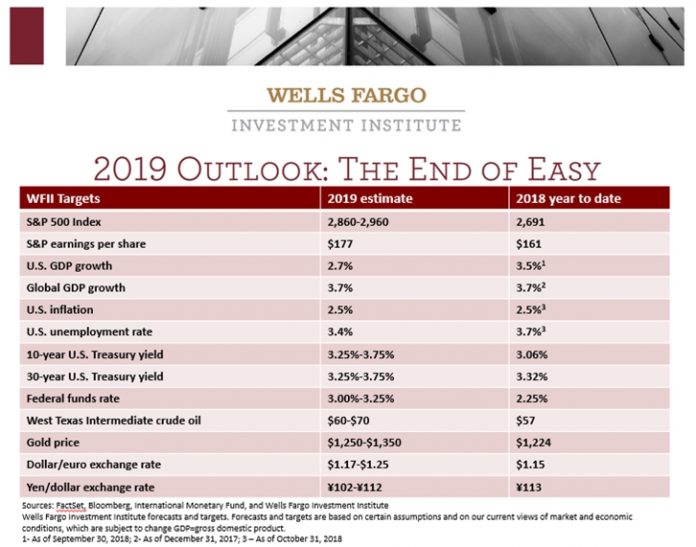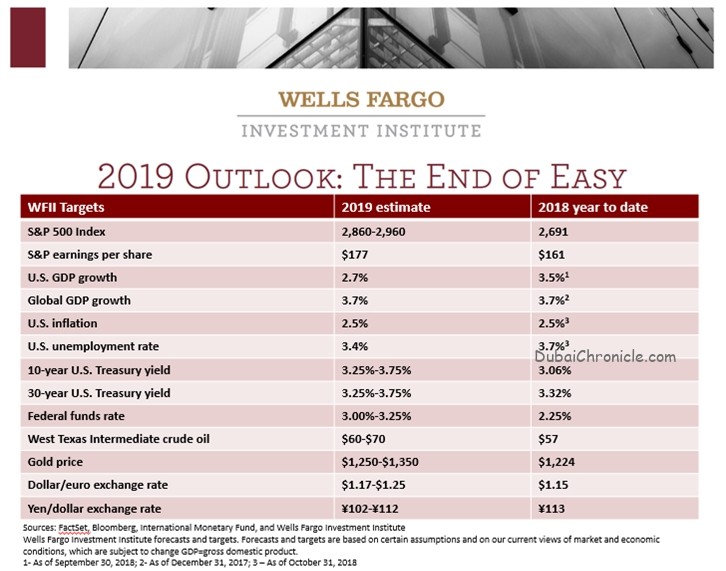
Wells Fargo Investment Institute today releases “2019 Outlook: The End of Easy,” offering guidance to investors for the coming year. It suggests 2019 will be marked by ever-changing conditions as the economic recovery of the past decade decelerates.
“2018 brought an end to exceptionally low volatility and above-average asset returns across equities, fixed income and currencies in the United States,” said Darrell Cronk, president of Wells Fargo Investment Institute and chief investment officer of Wells Fargo Wealth and Investment Management. “Trends of the past decade — equity and bond prices rising together, domestic markets outperforming international markets, outsized investor performance coming from only a few equity sectors — are now shifting. We are not living in a world of smooth sailing, and investors must be more stringent in 2019 when positioning their portfolios to achieve gains and pare risk.”
The investment outlook provides five areas for investors to consider in 2019:
1. Expect growth in equity markets, as we estimate emerging market-growth of up to 20 percent.
2. Consider enough bonds, because they may help stabilize portfolios when equities decline.
3. Include international assets, which could be helped by a weaker U.S. dollar and trade progress.
4. Lower allocations to the most rate-sensitive assets, including REITs and most bonds.
5. Strive to manage volatility risk with a portfolio mix of asset classes that spans sizes, geographies and sectors as competition among companies intensifies.
“2019 Outlook: The End of Easy” offers an in-depth analysis of economic and market forecasts with emphasis on the global economy, equities, fixed income, real assets, alternative investments and portfolio implementation actions. Watch a video with strategists discussing what could surprise the markets in 2019.
The institute will produce thematic research in 2019 on longer-term themes for investors to watch:
- China’s place in the world: How China’s rise relates to the dominance of the U.S. dollar, trade, capital markets and the economy.
- New approach to retirement: Investors across the baby boomer, Generation X and Millennial generations prepare differently.
- How do recoveries end? Anatomy of the next recession: What the next recession will look like and how investors can prepare their portfolios accordingly.
Risk Factors
Stocks may fluctuate in response to general economic and market conditions, the prospects of individual companies, and industry sectors. Foreign investing has additional risks including those associated with currency fluctuation, political and economic instability, and different accounting standards. Bonds are subject to interest rate, credit/default, liquidity, inflation and other risks. Prices tend to be inversely affected by changes in interest rates. Real estate has special risks including the possible illiquidity of underlying properties, credit risk, interest rate fluctuations and the impact of varied economic condition.

Alternative investments carry specific investor qualifications which can include high income and net-worth requirements as well as relatively high investment minimums. They are complex investment vehicles which generally have high costs and substantial risks. The high expenses often associated with these investments must be offset by trading profits and other income. They tend to be more volatile than other types of investments and present an increased risk of investment loss. There may also be a lack of transparency as to the underlying assets. Other risks may apply as well, depending on the specific investment product.
Asset allocation cannot eliminate the risk of fluctuating prices and uncertain returns.




































